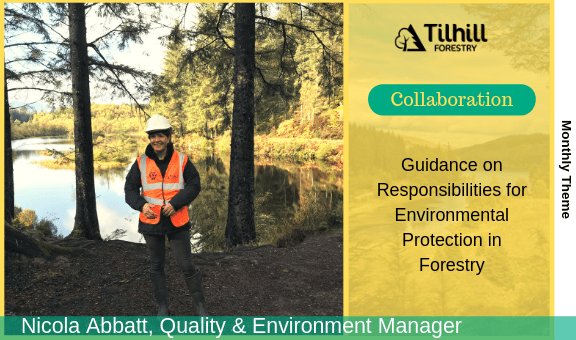Collaboration: Nicola Abbatt, Quality & Environment Manager
Nicola Abbatt is Tilhill Forestry’s Quality & Environmental Manager. She is working in collaboration with members of the Forest Industry Environment Group in order to produce an industry level Guidance on Responsibilities for Environmental Protection in Forestry. The latest draft of this can be found (here):
In order to find out more about the project, we asked her:
Q. What is the aim of the guidance?
A. To set clear guidelines on who is responsible for what when it comes to protecting our environment during forestry activities. When undertaking any work in our forests and woodlands, right from the onset, everyone needs to be clear of their individual role so environmental protection can be effectively planned.
The guide will provide basic information to help landowners, contractors and everyone in control of work activities in forestry in order to understand their role and responsibilities in environmental protection to meet legal requirements.
Q. Why is this a collaboration?
A. I am working on the guidance with other members of the Forest Industry Environment Group (FIEG). This group brings together individuals in the field of ecology and environmental management enabling them to share common interests and to work to resolve common problems in both the private and state forestry sectors.
As part of developing this guidance we have also collaborated with the Forest Industry Safety Accord (FISA) to align with their guidance Managing Health & Safety in Forestry (here).
Review and comments in drafting have been sought from environmental and compliance professionals, ecologists and representatives from all the duty holder’s concerned (Landowner to forestry worker). We have also had input from the environmental regulators including SEPA and NRW.
Q. What does each side contribute to this group?
A. Each party involved in reviewing and contributing brings their personal experience, skills and of course their time to work towards the common goal of environmental protection. Whether they be a woodland owner or a machine operator each has a different perspective on where their responsibilities lie. Identifying current weaknesses in practice and individual experience of how we can prevent things going wrong and improve as an industry, all contribute to achieving our end goal.
Q. What outcomes are you hoping for?
A. When everyone knows what their responsibilities are, you can plan and prepare better, the quality of work improves and we have environment protection assured.
Ultimately, my goal is to ensure that environmental protection is fully understood and considered at every stage of our activities and that we work towards integrating health, safety and environmental protection wherever possible to avoid duplication and focus communication.
This new guide starts this process and will fundamentally help to underpin a positive environmental culture across our industry.



